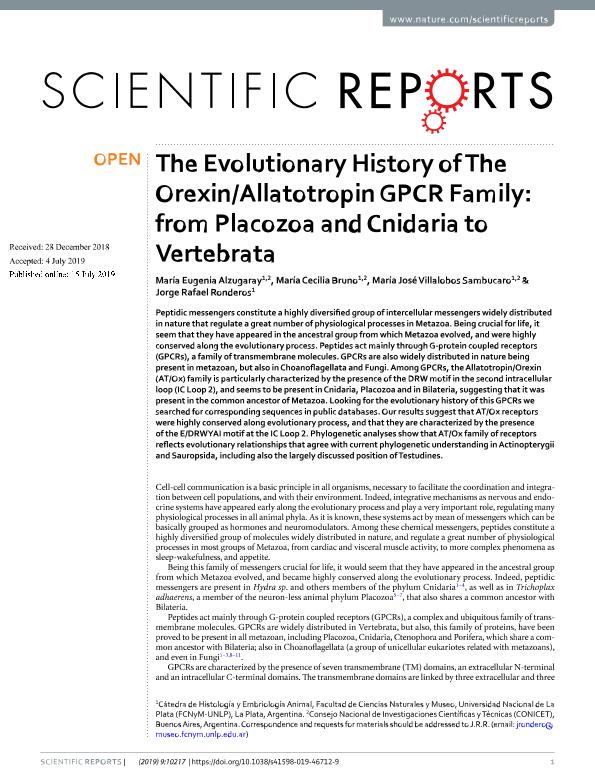Artículo
The Evolutionary History of The Orexin/Allatotropin GPCR Family: From Placozoa and Cnidaria to Vertebrata
Alzugaray, Maria Eugenia ; Bruno, María Cecilia
; Bruno, María Cecilia ; Villalobos Sambucaro, María José
; Villalobos Sambucaro, María José ; Ronderos, Jorge Rafael
; Ronderos, Jorge Rafael
 ; Bruno, María Cecilia
; Bruno, María Cecilia ; Villalobos Sambucaro, María José
; Villalobos Sambucaro, María José ; Ronderos, Jorge Rafael
; Ronderos, Jorge Rafael
Fecha de publicación:
07/2019
Editorial:
Nature Research
Revista:
Scientific Reports
ISSN:
2045-2322
Idioma:
Inglés
Tipo de recurso:
Artículo publicado
Clasificación temática:
Resumen
Peptidic messengers constitute a highly diversified group of intercellular messengers widely distributedin nature that regulate a great number of physiological processes in Metazoa. Being crucial for life, itseem that they have appeared in the ancestral group from which Metazoa evolved, and were highlyconserved along the evolutionary process. Peptides act mainly through G-protein coupled receptors(GPCRs), a family of transmembrane molecules. GPCRs are also widely distributed in nature beingpresent in metazoan, but also in Choanoflagellata and Fungi. Among GPCRs, the Allatotropin/Orexin(AT/Ox) family is particularly characterized by the presence of the DRW motif in the second intracellularloop (IC Loop 2), and seems to be present in Cnidaria, Placozoa and in Bilateria, suggesting that it waspresent in the common ancestor of Metazoa. Looking for the evolutionary history of this GPCRs wesearched for corresponding sequences in public databases. Our results suggest that AT/Ox receptorswere highly conserved along evolutionary process, and that they are characterized by the presenceof the E/DRWYAI motif at the IC Loop 2. Phylogenetic analyses show that AT/Ox family of receptorsreflects evolutionary relationships that agree with current phylogenetic understanding in Actinopterygiiand Sauropsida, including also the largely discussed position of Testudines
Palabras clave:
Allatotropin
,
Orexin
,
Evolution
,
GPCR
Archivos asociados
Licencia
Identificadores
Colecciones
Articulos(CCT - LA PLATA)
Articulos de CTRO.CIENTIFICO TECNOL.CONICET - LA PLATA
Articulos de CTRO.CIENTIFICO TECNOL.CONICET - LA PLATA
Articulos(IGEVET)
Articulos de INST.DE GENETICA VET ING FERNANDO NOEL DULOUT
Articulos de INST.DE GENETICA VET ING FERNANDO NOEL DULOUT
Citación
Alzugaray, Maria Eugenia; Bruno, María Cecilia; Villalobos Sambucaro, María José; Ronderos, Jorge Rafael; The Evolutionary History of The Orexin/Allatotropin GPCR Family: From Placozoa and Cnidaria to Vertebrata; Nature Research; Scientific Reports; 9; 7-2019; 1-11
Compartir
Altmétricas



